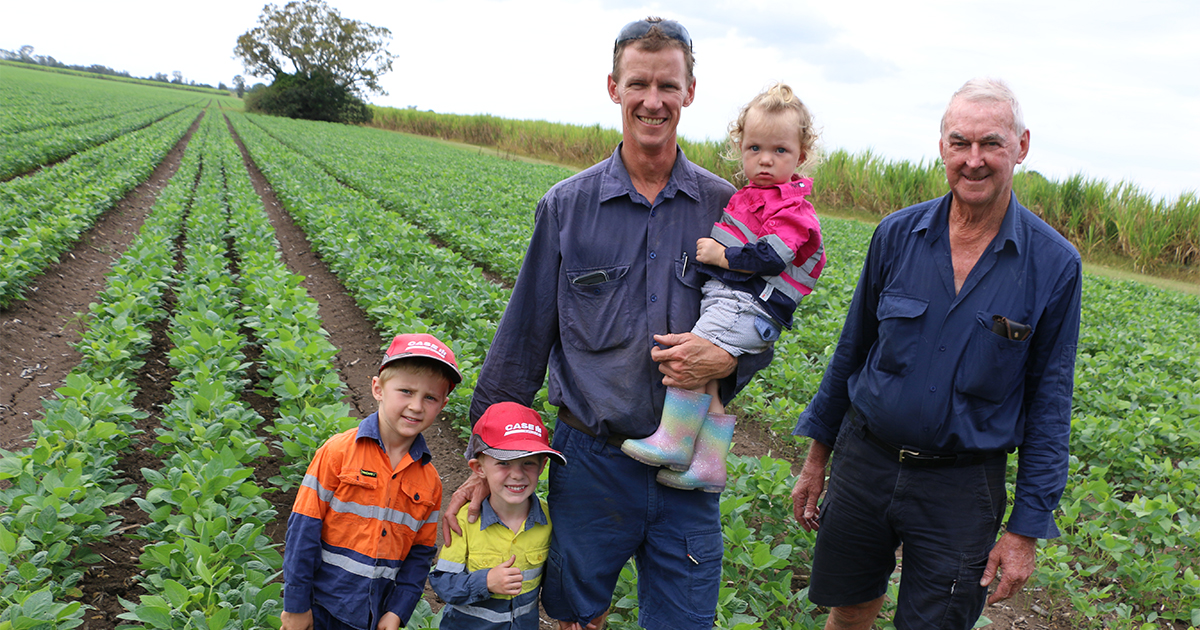Innovation and sustainability drives long-term farming success
By Brad Pfeffer, SRA
The Walsh family at Woodburn in northern NSW are passionate about sugarcane farming, and doing everything they can to make their farm profitable and sustainable for the long term.
With more than 100 years of cane growing history, the Walsh family has seen plenty of changes and innovations to the industry.
Farming at Woodburn in the Broadwater mill area, Tom is fourth generation at the family property and son Marty is fifth generation. They farm about 440 hectares of cane over several farms in the area, with the original property dating back to the start of cane growing in the region.
Both are keen to continue to improve the property for the next generation after them.
They have gone to 1.8 metre dual row, with three rows of soybeans following the same footprint at the end of the crop cycle. All their equipment is on GPS and they have also moved to disc opener planters for both cane and beans.
These changes are all helping to minimise time in the tractor, reduce soil disturbance and provide a controlled traffic path that can assist when it gets wet during the harvest. They also have some machinery in partnership with other local growers to help with things such as the bean harvest.
“We are happy with the dual-row 1.8 metre and have been that way for more than 15 years now,” Marty said. “With single row there can be a massive inter-row to cover in, but the dual row covers in very quickly.”
Beans are an important part of the mix, and a handy cash crop, but they have learnt through experience never to bank on them until they are in the truck.
 Marty and Tom Walsh with the next generation – Thomas, Eli and Emmy.
Marty and Tom Walsh with the next generation – Thomas, Eli and Emmy.
“We had an excellent crop in 2017 of about 60 hectares but we only harvested about 8 hectares with two big floods that year,” Tom said. “The first flood knocked them around and then the second flood there was water completely over the top and we lost virtually all our beans. Probably 70 – 80 percent of the beans in the region were lost that year – so while they are a good crop, they’re also quite risky.”
They have moved more towards the beans to both improve soil health and to give themselves plenty of time for getting the next crop of cane in. “If we were ploughing out cane in June or July, and then trying to plant in September the turnaround was too hard. So now we will plant beans in December and take the beans off around April or May, and then the block is there nicely prepared for September planting.”
They said the 2018 cane harvest was slightly below average, and impacted from two floods in 2017 floods.
“Some of our farms had half a metre of water over them, and while the cane survived it all, it did some lasting damage,” Tom said. “We had cane that looked like it would cut 150 tonnes/hectare and ended up more in that 110-120t/ha range. We still managed to cut about 23,000t all together, with good sugar.”
Their main varieties are Q208A, Q240A, Q232A and Q244A and they said that Q244A is their leading variety for sugar content. They had paddocks average over 15 CCS last year which they described as “pretty amazing”.
2018-19 – like most of NSW – was looking very dry early in the summer and they were in need of rain at the time of writing. “We hope to get back to cutting heavier cane and have often averaged 170-180t/ha, so we’re hoping to get back to that.”
They cut almost all two year old and see it as a safe bet to manage their reasonably high frost risk. They will grow one-year to balance different paddocks from time to time but also find that a cold and frosty winter will see the crop not perform as well the following year. The Walsh’s said they love farming, and are especially passionate about the cane industry. They are hopeful that the next generation will be keen to be farmers too, with Marty’s kids Thomas (5), Eli (3) and Emmy (1) already showing a keen interest.
Source: Autumn 2019 Cane Connection article re-published with permission from SRA.
Read Pulse Check blog articles | Pulse Check Coastal facebook | Subscribe to the monthly newsletter

